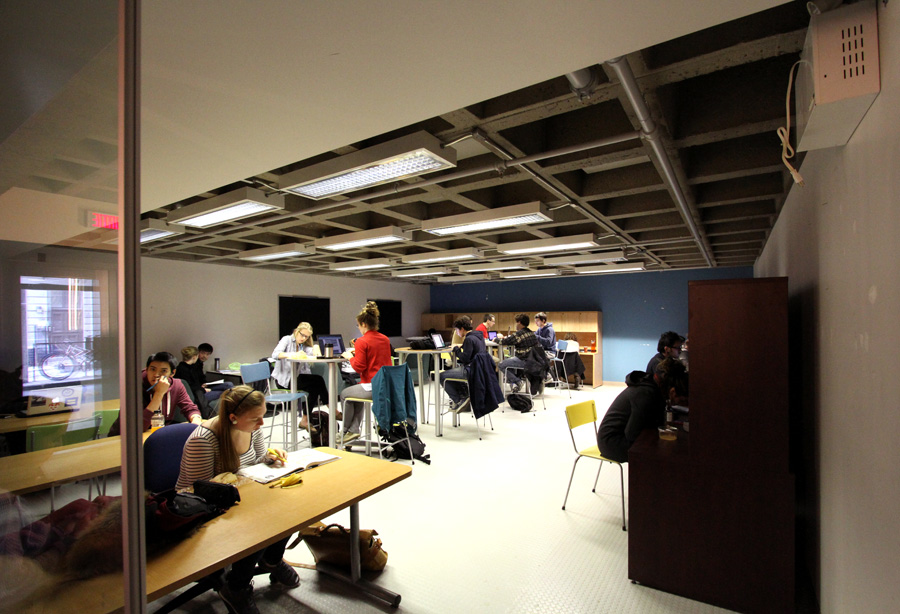The latest version of the People, Processes, and Partnerships (PPP) restructuring plan for McGill’s Leacock Building features two additional administrative hubs and more teaching assistant (TA) cubicles.
Faculty of Arts Associate Dean Gillian Lane-Mercier announced the changes to the plan at the Arts Undergraduate Society (AUS) Council meeting last Wednesday.
The PPP was introduced in Fall 2012 as a project that aims to reorganize the administrative services in the Faculty of Arts in light of staff reductions through the voluntary retirement program and decreased funding from the Quebec government.
“[We are] trying to make these administrative unit hubs robust enough to sustain the early retirement departures and upcoming normal retirements which will continue as we are not allowed to hire,” Lane-Mercier said. “There is a complete hiring freeze, and we do not know how long it will last.”
She went on to say that the PPP initiative will ensure sufficient administrative services for the Faculty of Arts in the face of unpredictable funding from the province.
“We don’t know if the Quebec government will begin to reinvest in Quebec universities,” Lane-Mercier said. “We are not 100 per cent convinced that they will be reinvesting in administrative services, so we wanted to be ready to really remain robust.”
In the initial floor plans announced in April, the third floor of Leacock was the designated space for administrative services. However, Lane-Mercier said current plans will leave the third floor unchanged. Instead, there will be two administrative hubs on different floors—each responsible for its own set of departments.
The first administrative hub will be located on the fourth floor and include the departments of Economics, Political Science, and Philosophy. On the seventh floor, a second hub will be devoted to the departments of History, Sociology, Anthropology, and Jewish Studies.
“[The groupings] took a lot of thinking and statistics,” Lane-Mercier said. “We have huge units, small units, and a couple of more medium-sized units [in Leacock], so we just wanted to make sure we were not overburdening one hub with respect to the other hub. We tried to really get the work load for the administrators to be balanced and also to ensure balanced student services.”
Along with the two administrative hubs, revisions to the restructuring program include the construction of seven more TA cubicles inside Leacock 111 and the repurposing of room 608 into a seminar room.
AUS President Justin Fletcher said the two additions will be beneficial to students.
“The discussion of adding seven TA cubicles in Leacock 111 is really important,” Fletcher said. “It’s a good study space right now, but there’s a lack of TA-student meeting areas. This not only allows for confidentiality, but after hours, it’s a group study area and allows for collaboration in a quiet space.”
Lane-Mercier emphasized that the question of space in Leacock is most pertinent to students.
“[We have a] good opportunity to rethink inner spaces, how to repurpose inner spaces for students,” she said. “I think sharing is a great idea. There’s no reason why undergraduate students couldn’t have a shared student space with two or more departments.”
According to AUS Vice-President Communications Lucy Ava Liu, students can get involved through various sub-groups of the PPP.
“Students can be involved by communicating the AUS their concerns,” Liu said. “The most direct impact for students is the concrete change in departmental administrative locations, and students in certain departments will need to familiarize themselves with new office locations for their departments’ administrative staff.”
Fletcher highlighted the importance of receiving input from students in order to ensure that the restructuring project is beneficial to them.
“Interior spaces in Leacock are going to be decided by departments,” Fletcher said. “It’s important for students involved in their departmental association to speak with their department chair to say […] how we would like space to be utilized. Students need to be active in discussing the allocation of these interior spaces.”
The move is scheduled to begin this summer in order to reduce disruptions. The additional TA cubicles are expected to be completed by next Fall semester.









